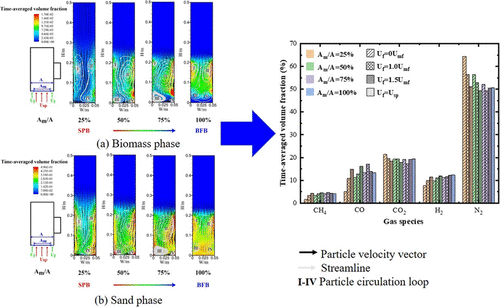当前位置:
X-MOL 学术
›
Energy Fuels
›
论文详情
Our official English website, www.x-mol.net, welcomes your feedback! (Note: you will need to create a separate account there.)
Modeling and Optimization for Gas Distribution Patterns on Biomass Gasification Performance of a Bubbling Spout Fluidized Bed
Energy & Fuels ( IF 5.3 ) Pub Date : 2020-02-10 , DOI: 10.1021/acs.energyfuels.9b02512 Panxing Kang 1 , Xiayi Eric Hu 1, 2 , Yujian Lu 1 , Kuang Wang 1 , Rui Zhang 1 , Luchang Han 1 , Haizhuan Yuan 3 , Hongbo Chen 1 , Xiao Luo 4 , Yefeng Jeffrey Zhou 1, 2
Energy & Fuels ( IF 5.3 ) Pub Date : 2020-02-10 , DOI: 10.1021/acs.energyfuels.9b02512 Panxing Kang 1 , Xiayi Eric Hu 1, 2 , Yujian Lu 1 , Kuang Wang 1 , Rui Zhang 1 , Luchang Han 1 , Haizhuan Yuan 3 , Hongbo Chen 1 , Xiao Luo 4 , Yefeng Jeffrey Zhou 1, 2
Affiliation

|
Gas distribution patterns exert a great impact on the gas–solid flow, heat and mass transfer, and reaction characteristics and thus affect significantly the thermal conversion efficiency inside the biomass gasifier. In this study, a two-dimensional biomass gasification model for a bubbling spout fluidized-bed gasifier (BSFBG) is established based on the kinetic theory of granular mixture (KTGM), and the prediction accuracy of the model is verified through a comparison between simulation values and experimental values. Furthermore, with the total mass flow rate of the inlet gas set constant, the study has investigated how the ratio of the inlet cross-sectional area to reactor area (Am/A) and the auxiliary gas velocity (Uf) affect the gas–solid flow, heat transfer, and gasification performance in the BSFBG. As the results indicate, with Am/A increasing, the local particle flow structure becomes increasingly complex, particle volume fraction and temperature get more evenly distributed, and the volume fraction of outlet key gas species (CO, H2, and CH4) and the lower heating value (LHV) is gradually rising. Besides, compared with the even gas distribution condition (Am/A = 100%), the formation of overall and local counterclockwise particle circulation is facilitated by either a relatively high Uf with a low Am/A (≤50%) or a relatively low Uf with a high Am/A (≥75%). The circulation structure strengthens the gas–solid mixing in the pyrolysis zone and gasification zone in the middle-upper part of the dense phase bed, which makes the volume fraction of outlet key gas species and LHV increase significantly. In the meanwhile, when Am/A = 75% and Uf = 1.0Umf, both the volume fraction and LHV reach the maximums, indicating that the overall gasification performance achieves the optimal state. In conclusion, this study is of reference value for the investigation and intensification of the gasification process, which helps to optimize BSFBG design and thus improve the biomass thermal conversion efficiency.
中文翻译:

冒泡流化床生物质气化性能的气体分布模式建模与优化
气体分布方式对气固流,传热和传质以及反应特性有很大影响,因此会显着影响生物质气化炉内部的热转化效率。本研究基于颗粒混合物动力学理论(KTGM),建立了鼓泡喷头流化床气化炉(BSFBG)的二维生物质气化模型,并通过仿真对比验证了该模型的预测精度。值和实验值。此外,在使进气总质量流量恒定的情况下,研究研究了进气截面积与反应器面积之比(A m / A)与辅助气体速度(U f)的关系。)会影响BSFBG中的气固流动,传热和气化性能。结果表明,随着A m / A的增加,局部颗粒流结构变得越来越复杂,颗粒体积分数和温度分布更加均匀,出口关键气体物种(CO,H 2和CH 4)的体积分数较低的发热量(LHV)逐渐升高。此外,与均匀的气体分布条件(A m / A = 100%)相比,较高的U f和较低的A m可促进整体和局部逆时针粒子循环的形成。/ A(≤50%)或相对较低的U f和较高的A m / A(≥75%)。循环结构加强了密相床中上部热解区和气化区的气固混合,这使得出口关键气体种类和LHV的体积分数显着增加。同时,当A m / A = 75%且U f = 1.0 U mf时,体积分数和LHV都达到最大值,表明整体气化性能达到了最佳状态。综上所述,该研究对气化过程的研究和强化具有参考价值,有助于优化BSFBG的设计,从而提高生物质的热转化效率。
更新日期:2020-02-10
中文翻译:

冒泡流化床生物质气化性能的气体分布模式建模与优化
气体分布方式对气固流,传热和传质以及反应特性有很大影响,因此会显着影响生物质气化炉内部的热转化效率。本研究基于颗粒混合物动力学理论(KTGM),建立了鼓泡喷头流化床气化炉(BSFBG)的二维生物质气化模型,并通过仿真对比验证了该模型的预测精度。值和实验值。此外,在使进气总质量流量恒定的情况下,研究研究了进气截面积与反应器面积之比(A m / A)与辅助气体速度(U f)的关系。)会影响BSFBG中的气固流动,传热和气化性能。结果表明,随着A m / A的增加,局部颗粒流结构变得越来越复杂,颗粒体积分数和温度分布更加均匀,出口关键气体物种(CO,H 2和CH 4)的体积分数较低的发热量(LHV)逐渐升高。此外,与均匀的气体分布条件(A m / A = 100%)相比,较高的U f和较低的A m可促进整体和局部逆时针粒子循环的形成。/ A(≤50%)或相对较低的U f和较高的A m / A(≥75%)。循环结构加强了密相床中上部热解区和气化区的气固混合,这使得出口关键气体种类和LHV的体积分数显着增加。同时,当A m / A = 75%且U f = 1.0 U mf时,体积分数和LHV都达到最大值,表明整体气化性能达到了最佳状态。综上所述,该研究对气化过程的研究和强化具有参考价值,有助于优化BSFBG的设计,从而提高生物质的热转化效率。


























 京公网安备 11010802027423号
京公网安备 11010802027423号